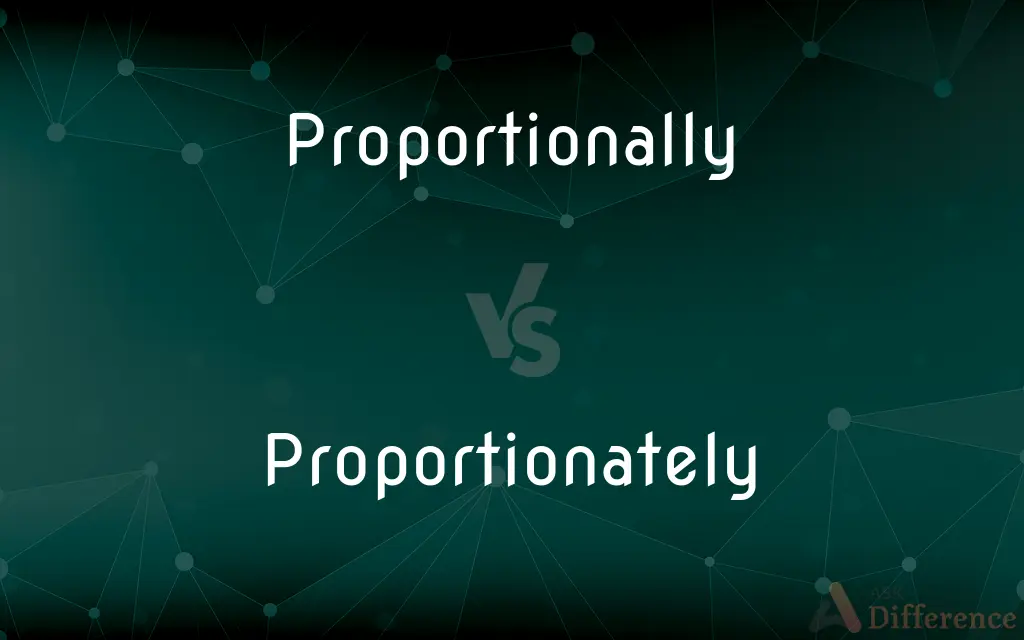Proportionally vs. Proportionately — What's the Difference?
By Fiza Rafique & Maham Liaqat — Updated on March 22, 2024
"Proportionally" refers to adjusting quantities in relation to each other based on a common factor, while "proportionately" implies a more general sense of balance and equivalence in size, amount, or degree between different elements.

Difference Between Proportionally and Proportionately
Table of Contents
ADVERTISEMENT
Key Differences
Proportionally is used when there's a direct mathematical or quantitative relationship between things, ensuring each part is adjusted according to a specific ratio or scale. Proportionately, on the other hand, carries a broader sense of even distribution or scaling, often used when discussing fairness or balance without strict mathematical connotations.
When you adjust something proportionally, you're often dealing with precise measurements, such as resizing an image while keeping its dimensions consistent. Proportionately might be used in contexts like distributing resources, where the emphasis is on equitable sharing based on size, amount, or importance, without implying a strict mathematical formula.
In design or art, elements might be scaled proportionally to maintain their relative sizes and harmony within a composition. Meanwhile, proportionately could describe how different sectors of an economy grow in a way that maintains a balanced relationship, not necessarily tied to a fixed ratio.
Proportionally is typically employed in more technical or scientific contexts, where accuracy and specific ratios are crucial. Proportionately might be found in discussions about social justice or economics, where the concept of fairness and balance is emphasized over exact proportions.
In summary, while both terms deal with relationships between quantities or sizes, proportionally is more about maintaining a specific ratio, and proportionately leans towards a broader concept of balance and equitable distribution.
ADVERTISEMENT
Comparison Chart
Definition
Adjusting quantities in relation to each other based on a specific ratio or scale.
Ensuring balance or equivalence in size, amount, or degree in a broader sense.
Usage Context
Often used in technical, mathematical, or scientific contexts.
More commonly used in general discussions about fairness, balance, or equivalence.
Connotation
Implies a precise mathematical relationship or ratio.
Suggests a general sense of balance or even distribution, not strictly mathematical.
Examples
Resizing an image while maintaining aspect ratio.
Distributing resources among a group in a way that feels fair.
Focus
Maintaining specific ratios or scales.
Achieving a balanced or equitable relationship between elements.
Compare with Definitions
Proportionally
Adjusting based on a specific ratio.
The ingredients were increased proportionally for the larger batch.
Proportionately
Distributing or adjusting to achieve balance.
The profits were divided proportionately among the team members.
Proportionally
Keeping consistent dimensions in scaling.
The graphic was resized proportionally to fit the new layout.
Proportionately
Reflecting fairness or equity in distribution.
Aid was given proportionately to the needs of each region.
Proportionally
Used in precise adjustments or calculations.
The budget was allocated proportionally among departments based on size.
Proportionately
Related to balanced growth or development.
Investments were increased proportionately with the company's revenue growth.
Proportionally
Reflecting a direct mathematical relationship.
The response was proportionally related to the stimulus intensity.
Proportionately
Used in a broader, often non-mathematical context.
Responsibilities are assigned proportionately to each member's expertise.
Proportionally
Related to proportional representation.
Votes in the council are assigned proportionally based on population.
Proportionately
Implies a sense of harmony or equivalence.
The furniture was arranged proportionately to create a balanced space.
Proportionally
Forming a relationship with other parts or quantities; being in proportion.
Proportionately
Being in due proportion; proportional.
Proportionally
Properly related in size, degree, or other measurable characteristics; corresponding
Punishment ought to be proportional to the crime.
Proportionately
To make proportionate.
Proportionally
(Mathematics) Having the same or a constant ratio.
Proportionately
In a proportionate manner; with due proportion; proportionally.
Proportionally
One of the quantities in a mathematical proportion.
Proportionately
In a proportionate manner; with due proportion; proportionally.
Proportionally
In proportion; in due degree; adapted relatively.
Proportionately
To a proportionate degree;
Your salary will rise proportionately to your workload
Proportionally
In proportion; in due degree; adapted relatively; as, all parts of the building are proportionally large.
Proportionately
To a proportionate degree;
The height of this wall must be reduced proportionately to give the room pleasant dimensions
Proportionally
To a proportionate degree;
Your salary will rise proportionately to your workload
Proportionately
In proportion
Common Curiosities
Is proportionally used more in mathematics?
Yes, proportionally is more common in mathematical, scientific, or technical contexts where precise ratios and relationships are important.
How is proportionately different from proportionally?
Proportionately implies a broader sense of balance or fairness in distribution or size, without necessarily adhering to a precise mathematical ratio like proportionally.
What does it mean to adjust something proportionally?
Adjusting proportionally means changing the size or quantity of something according to a specific ratio or scale, ensuring that all parts remain in the same relative proportion.
Can you give an example of proportional adjustment?
Resizing a digital image proportionally means changing its width and height so that it retains its original aspect ratio.
What is an example of proportionate distribution?
Distributing relief funds proportionately based on the level of damage or need in different areas is an example of proportionate distribution.
Can proportionately be used in discussions about fairness?
Yes, proportionately is often used in contexts related to fairness, equity, and balanced distribution, where the focus is on equitable rather than exact distribution.
How does proportional scaling work in design?
In design, proportional scaling involves adjusting the size of elements so that they keep their original proportions, ensuring the overall harmony of the design.
Is it possible to adjust something proportionately without specific measurements?
Yes, adjusting proportionately can involve making changes that feel balanced or fair, without necessarily using specific measurements or ratios.
How do proportional and proportionate adjustments impact outcomes?
Proportional adjustments ensure outcomes maintain a consistent ratio, while proportionate adjustments aim for a balanced or fair outcome, potentially leading to different distributions or designs based on the context.
What does it mean to grow proportionately?
Growing proportionately means expanding in size, amount, or degree in a way that maintains a balanced or fair relationship between different parts or aspects.
Share Your Discovery

Previous Comparison
Concise vs. Short
Next Comparison
Ram vs. TupAuthor Spotlight
Written by
Fiza RafiqueFiza Rafique is a skilled content writer at AskDifference.com, where she meticulously refines and enhances written pieces. Drawing from her vast editorial expertise, Fiza ensures clarity, accuracy, and precision in every article. Passionate about language, she continually seeks to elevate the quality of content for readers worldwide.
Co-written by
Maham Liaqat













































